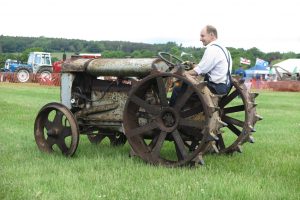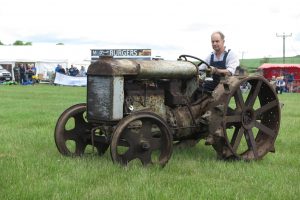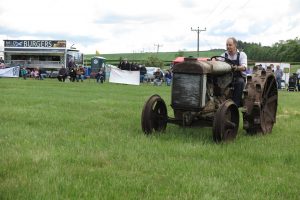 The year 2017 marks 100 years of Ford tractors in Britain. At that time Ford was not the only tractor makers selling tractors in Britain. The trials of tractors by the Highland and Agricultural Society of Scotland and the Royal Agricultural Society of England from 1917 until the early 1920s attracted a good number of makers, many of which soon disappeared. But not all of these advertised their manufactures to the Scottish farmer, or indeed could be easily purchased.
The year 2017 marks 100 years of Ford tractors in Britain. At that time Ford was not the only tractor makers selling tractors in Britain. The trials of tractors by the Highland and Agricultural Society of Scotland and the Royal Agricultural Society of England from 1917 until the early 1920s attracted a good number of makers, many of which soon disappeared. But not all of these advertised their manufactures to the Scottish farmer, or indeed could be easily purchased.
The North British Agriculturist and the Scottish farmer carried a number of adverts for the early tractors, providing evidence of what was available to the Scottish farmer to purchase. These were placed either directly by the makers themselves or a small number of agents, some in Scotland, though more often in England. There, were, however, few outlets from which to purchase one.
 Perhaps the most widely advertised tractor was the “Avery” paraffin tractor, usually used alongside Cockshut ploughs. The agent was a well-known English agricultural and implement maker, R. A. Lister & Co. Ltd, Dursley, known for its engines (you will see many of them along the stationary engines in the rallies).
Perhaps the most widely advertised tractor was the “Avery” paraffin tractor, usually used alongside Cockshut ploughs. The agent was a well-known English agricultural and implement maker, R. A. Lister & Co. Ltd, Dursley, known for its engines (you will see many of them along the stationary engines in the rallies).
The “Avery” competed with the Whiting Bull paraffin tractor, sold by Whiting 1915 Ltd, in London; its agents for the south of Scotland were John Croall & Sons Ltd, Castle Terrace, Edinburgh. Its tractors were specially designed to be used by women, having a view to the acute shortage of male workers on the land. It advertised its tractors through the ease of their use and as “the acme in tractor construction”: it combined efficiency, economy and utility. It was a 24 hp engine with 4 cylinders. It was an already established tractor, with the company noting that “the Whiting-Bulll paraffin tractor has been working in many parts of England for two years past. It is one of the most popular machines in the United States, where over 25,000 are in use at the present time.” It was demonstrated at a number of farms throughout the country, including public one on James W. Scarlett’s farm at Inveresk, in July.
 The “Moline” was sold by one of the largest implement and machine makers in Scotland: John Wallace & Sons Ltd, Implement Works, Dennistoun, Glasgow. It was sold alongside its tractor plow (as well as Oliver plows for which Wallace had a reputation. It emphasised how easy it was to work: “Easter handled than team”, with a turn of 16 feet and a weight of 26 cwt with all weight on the drive wheels. It was adaptable to all farm implements, could work close to hedged and could be used on small or large fields.
The “Moline” was sold by one of the largest implement and machine makers in Scotland: John Wallace & Sons Ltd, Implement Works, Dennistoun, Glasgow. It was sold alongside its tractor plow (as well as Oliver plows for which Wallace had a reputation. It emphasised how easy it was to work: “Easter handled than team”, with a turn of 16 feet and a weight of 26 cwt with all weight on the drive wheels. It was adaptable to all farm implements, could work close to hedged and could be used on small or large fields.
By late 1917 the Mogul, was being sold by one of the largest Edinburgh implement and machine makers: A. & J. Main & Co. Ltd, Edinburgh. It also sold the Martin Motor plough with caterpillar traction. Another tractor to be advertised late in the year was the Wallis Cub Junior was also being sold by Rossleigh Ltd, Shandwick Place, and the Overtime from tractor, whose agent was Mr H. Storer, Blythswood Hotel, Glasgow: it was described as “an all year round tractor for the average farm, and can be used for all work on the farm previously done by horses, including ploughing, cultivating, harvesting, mowing, threshing, chaff cutting, &c”. The company reported that there were over 3,000 “Overtimes” in the British Isles.
 Farmers looking fora smaller tractor could purchase the Bates’ steel mule – approved by purchase by the Board of Agriculture. It was supplied by the Power-Farm Supply Co., Coventry. It reminder readers “with a Bates steel mule you can not only do the work of ten horses in ploughing with one only, but, as with no other tractor, you can do it regardless of the ground condition, and the Mule will do your cultivating, seeding, rolling, and all other work on already broken up land, as well as help you in your hay and harvest work, and drive your fixed machinery, from a 54in threshing machine downwards.” Quite a list of uses!
Farmers looking fora smaller tractor could purchase the Bates’ steel mule – approved by purchase by the Board of Agriculture. It was supplied by the Power-Farm Supply Co., Coventry. It reminder readers “with a Bates steel mule you can not only do the work of ten horses in ploughing with one only, but, as with no other tractor, you can do it regardless of the ground condition, and the Mule will do your cultivating, seeding, rolling, and all other work on already broken up land, as well as help you in your hay and harvest work, and drive your fixed machinery, from a 54in threshing machine downwards.” Quite a list of uses!
However, the new Ford tractor, demonstrated at the trials of the Royal Agricultural Society of England was not advertised in the North British Agriculturist of 1917. That was not to take place until the following year.
If you were a farmer in 1917 you could not help but notice the winds of change blowing through the world of agriculture with the large and striking adverts placed by tractor makers and agents. The adverts emphasised the simplicity, efficiency and ease of working of the tractors. They were modern and attractiv, just like the manufactures they were advertising.
The photograph of the 1919 Fordson F was taken at the Fife Vintage Agricultural Machinery rally, June 1917.
